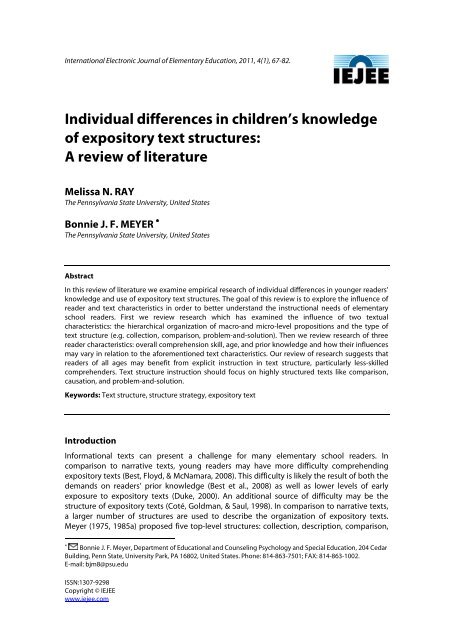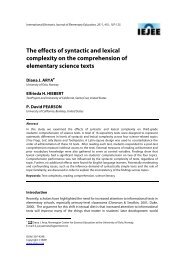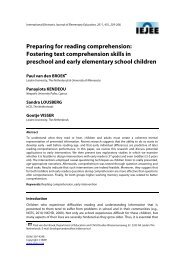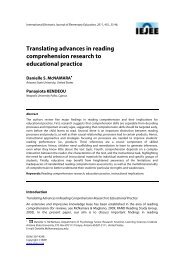Individual differences in children's knowledge of expository text ...
Individual differences in children's knowledge of expository text ...
Individual differences in children's knowledge of expository text ...
You also want an ePaper? Increase the reach of your titles
YUMPU automatically turns print PDFs into web optimized ePapers that Google loves.
<strong>Individual</strong> <strong>differences</strong> <strong>in</strong> children’s <strong>knowledge</strong> / Ray & Meyersentences fit with the stimulus sentences provided. The researchers found that children hadbetter judgments with the collection structure than the comparison, with performancelowest for comparison and description structures. This difference was present on targets(sentences that fit the structure) but not distractors (sentences that did not fit the structure)(Englert & Hiebert, 1984). Similarly, <strong>in</strong> their study <strong>of</strong> 4th -, 6th-, and 8th-graders’ recalls, Smithand Hahn (1989) found that comparison was used less frequently to organize recall thanenumeration and description. In both <strong>of</strong> these cases, levels <strong>of</strong> structural awareness wererelated to the age <strong>of</strong> the readers; older readers demonstrated greater <strong>knowledge</strong> <strong>of</strong> thecomparison structure, than younger readers. This relationship will be further discussed <strong>in</strong> alater section.Other researchers have shown patterns <strong>of</strong> children’s awareness that are somewhat similarto the patterns found with adults. Richgels, McGee, Lomax, & Sheard (1987) found that 6thgradereaders were more sensitive to the comparison structure than the other structuresexam<strong>in</strong>ed (collection, causation, problem-and-solution). They found that causation <strong>text</strong>sposed the greatest challenge to 6th-grade readers; performances on a match<strong>in</strong>g task as wellas organizational rat<strong>in</strong>gs <strong>of</strong> recalls and compositions were lowest for causation (Richgels etal., 1987). Similarly, Yochum (1991) found that 5th graders recalled more ideas when read<strong>in</strong>gcomparison <strong>text</strong>s than when read<strong>in</strong>g attribution (collection) <strong>text</strong>s. However, this effect for<strong>text</strong> structure was not found on a comprehension test. These f<strong>in</strong>d<strong>in</strong>gs suggest that likeadults, children may benefit from more organized <strong>text</strong> structures. However, unlike adults,children’s <strong>knowledge</strong> <strong>of</strong> <strong>text</strong> structure may still be develop<strong>in</strong>g, and those structures that aremost structured like the causation structure, may pose a challenge.In addition to the overall rhetorical structure, <strong>text</strong>ual signal<strong>in</strong>g devices that explicitly<strong>in</strong>dicate the structure <strong>of</strong> the <strong>text</strong> may also <strong>in</strong>fluence readers’ abilities to recognize and usethe <strong>text</strong> structure. Numerous studies which have exam<strong>in</strong>ed the <strong>in</strong>fluence <strong>of</strong> <strong>text</strong> signal<strong>in</strong>g onadult comprehension have demonstrated that signal<strong>in</strong>g is associated with a greater number<strong>of</strong> ideas recalled and more organized recalls (Kardash & Noel, 2000; Lorch & Lorch, 1985;Lorch, Lorch, & Inman, 1993; Ritchey, Schuster, & Allen, 2008; for an extensive review <strong>of</strong> <strong>text</strong>signal<strong>in</strong>g see Lorch, 1989). Research on younger readers’ sensitivity to signal<strong>in</strong>g revealssimilar effects. Ohlhausen and Roller (1988) <strong>in</strong> their exam<strong>in</strong>ation <strong>of</strong> younger readers’sensitivity to structural and content schemas found that <strong>text</strong>s which conta<strong>in</strong>ed elementshighlight<strong>in</strong>g both the structural and content organization were associated with a greaternumber <strong>of</strong> correct ma<strong>in</strong> ideas identified <strong>in</strong> comparison to those <strong>text</strong>s which emphasizedeither the structure or the content. Moreover readers exposed to a <strong>text</strong> which emphasizedthe <strong>text</strong> structure were better able to identify the structural organization (Ohlhausen &Roller, 1988). Similarly, Rossi (1990) found that structural schemas which highlightedmacrosentences and/or the overall rhetorical structure were associated with higherperformance on a test <strong>of</strong> comprehension and a larger number <strong>of</strong> <strong>text</strong> propositions produced<strong>in</strong> 5 th -grade readers’ summaries. The effectiveness <strong>of</strong> signals has been found to vary <strong>in</strong>relation to the overall comprehension skill <strong>of</strong> the reader (Meyer et al., 1980). Nevertheless,previous research suggests that provid<strong>in</strong>g <strong>in</strong>dices <strong>of</strong> the top-level structure <strong>of</strong> <strong>text</strong>s canfacilitate readers’ structural awareness by mak<strong>in</strong>g the structure more explicit.The Relationship between Reader and Text CharacteristicsIn this section, we will exam<strong>in</strong>e previous research which has <strong>in</strong>vestigated sources <strong>of</strong><strong>in</strong>dividual <strong>differences</strong> (read<strong>in</strong>g ability, age, prior <strong>knowledge</strong>) <strong>in</strong> structural awareness andtheir relationship to <strong>text</strong> characteristics. Although we will address these sources <strong>in</strong>dividually,many studies consider multiple reader and <strong>text</strong> <strong>in</strong>fluences simultaneously. Table 1 conta<strong>in</strong>s a71
<strong>Individual</strong> <strong>differences</strong> <strong>in</strong> children’s <strong>knowledge</strong> / Ray & Meyer[closed multiple choice question]). The open-ended questions showed that for high<strong>knowledge</strong> students, the causation plus comparison yielded better results than causationplus collection, while the opposite was true for low <strong>knowledge</strong> students. Armand also founda significant <strong>in</strong>teraction between prior <strong>knowledge</strong> and <strong>text</strong> structure for the multiple-choicequestions. However, for high <strong>knowledge</strong> readers there was no difference <strong>in</strong> performanceacross <strong>text</strong> structures, whereas low prior <strong>knowledge</strong> readers had better performance withthe causation plus collection structure. These f<strong>in</strong>d<strong>in</strong>gs suggest that prior <strong>knowledge</strong>mitigates the demands <strong>of</strong> read<strong>in</strong>g <strong>text</strong>s conta<strong>in</strong><strong>in</strong>g two, challeng<strong>in</strong>g yet more organized,structures for younger readers. Yekovich, Walker, Ogle, and Thompson (1990) found thathigh doma<strong>in</strong> <strong>knowledge</strong> (i.e., football) enabled low aptitude students to handle causalrelationships and other types <strong>of</strong> <strong>in</strong>ferences above what was expected based on theiraptitude test scores. In the Armand study high prior <strong>knowledge</strong> enabled 6th graders toprocess ideas from <strong>text</strong> <strong>in</strong> the more complex causal and comparative <strong>text</strong>, while those withlow prior <strong>knowledge</strong> found the complex causal and comparative <strong>text</strong> too difficult. Studentswith low prior <strong>knowledge</strong> could better understand the less process<strong>in</strong>g <strong>in</strong>tense causation pluscollection with its attributes grouped <strong>in</strong> a collection related to each tree. Similar to Wylie andMcGu<strong>in</strong>ness (2004), Armand’s f<strong>in</strong>d<strong>in</strong>g also suggests that low prior <strong>knowledge</strong> readers may beless able apply structural <strong>knowledge</strong> when the content demands are high. The causalstructure had been found to be particularly difficult with 6th graders (Richgels et al., 1987). Inthe Armand study with high prior <strong>knowledge</strong>, <strong>text</strong> structure <strong>differences</strong> did not matter forrecognition, but only with the deeper process<strong>in</strong>g needed for recall questions. Some <strong>text</strong>structures may be unfamiliar, or too difficult for a certa<strong>in</strong> grade levels or <strong>knowledge</strong> or skilllevels with<strong>in</strong> a grade level. Both the Armand as well as the Wylie and McGu<strong>in</strong>ness (2004)study discussed above suggest that with high doma<strong>in</strong> <strong>knowledge</strong>, the comparison structurecan be helpful for deeper understand<strong>in</strong>g.Unlike the more complex <strong>text</strong>s studied by Armand (2001), Yochum (1991) exam<strong>in</strong>ed theeffect <strong>of</strong> attribution (collection <strong>of</strong> descriptions) vs. comparison structures on 5th-graders’recall and performance on comprehension questions. Yochum failed to f<strong>in</strong>d an <strong>in</strong>teractionbetween <strong>text</strong> structure and prior <strong>knowledge</strong>. Both prior <strong>knowledge</strong> and <strong>text</strong> structurepredicted the number <strong>of</strong> ideas recalled, while only prior <strong>knowledge</strong> predictedcomprehension test scores. Neither prior <strong>knowledge</strong> nor <strong>text</strong> structure was associated withthe structure <strong>of</strong> recalls. This f<strong>in</strong>d<strong>in</strong>g suggests that while both prior <strong>knowledge</strong> and <strong>text</strong>structure <strong>in</strong>fluence comprehension, prior <strong>knowledge</strong> does not moderate the effect <strong>of</strong> <strong>text</strong>structure. However, one should be cautious about draw<strong>in</strong>g this conclusion because thestructure <strong>of</strong> the <strong>text</strong> did not <strong>in</strong>fluence organization <strong>of</strong> recall. Previous studies have <strong>in</strong>dicatedthat readers’ <strong>of</strong> this age have vary<strong>in</strong>g levels <strong>of</strong> sensitivity to these structures (e.g. Richgels, etal. 1987).Few studies and <strong>in</strong>consistencies <strong>in</strong> f<strong>in</strong>d<strong>in</strong>gs make it difficult to draw substantiveconclusions about the relationship between prior <strong>knowledge</strong> about <strong>text</strong> content and/or <strong>text</strong>structure and measures <strong>of</strong> structural awareness. This probably relates to the complexity <strong>of</strong>the <strong>in</strong>teractions between the reader variables <strong>of</strong> doma<strong>in</strong> <strong>knowledge</strong>, structure strategy<strong>knowledge</strong> with different types structures, general read<strong>in</strong>g skills, and the particular <strong>text</strong> to beread as well as the task demands. Nevertheless prior <strong>knowledge</strong> may impact readers’ need toavail themselves to the affordances <strong>of</strong> <strong>text</strong> structures. Additionally, the ability to apply<strong>knowledge</strong> <strong>of</strong> <strong>text</strong> structure may vary with the type <strong>of</strong> <strong>text</strong> structure used <strong>in</strong> a <strong>text</strong> (e.g.,causal vs. comparative structures).Summary <strong>of</strong> Research F<strong>in</strong>d<strong>in</strong>gs77
International Electronic Journal <strong>of</strong> Elementary EducationPrevious research <strong>in</strong>dicates that the <strong>in</strong>teraction between the <strong>knowledge</strong> and skills <strong>of</strong> thereader and the structural characteristics <strong>of</strong> the <strong>text</strong> <strong>in</strong>fluences readers’ structural awareness.Older readers possess <strong>knowledge</strong> <strong>of</strong> a larger set <strong>of</strong> <strong>text</strong> structures <strong>in</strong> comparison to youngerreaders. In develop<strong>in</strong>g awareness <strong>of</strong> <strong>expository</strong> <strong>text</strong> structures, readers’ move from a listlike/default strategy to a “structure strategy” as proposed by Meyer et al. (1980). Thisdevelopment <strong>of</strong> structural <strong>knowledge</strong> reflects the cont<strong>in</strong>uum <strong>of</strong> structural organizationproposed by Meyer and Freedle (1984). Less organized structures are likely acquired beforemore organized and more organized structures. Previous research <strong>in</strong>dicates that by 6 th -gradereaders demonstrate awareness <strong>of</strong> a variety <strong>of</strong> <strong>text</strong> structures (Richgels et al., 1987, Englert &Hiebert, 1984). Development <strong>of</strong> structural awareness may differ for less skilled readers, aslower overall comprehension skills may h<strong>in</strong>der these readers’ abilities to acquire greaterlevels <strong>of</strong> structural awareness. However, additional research is needed to further explore the<strong>in</strong>fluence comprehension skill has on the development <strong>of</strong> structural awareness. Moreover,even if readers have structural <strong>knowledge</strong>, the content <strong>knowledge</strong> demands <strong>of</strong> a <strong>text</strong> may<strong>in</strong>hibit their ability to apply structural <strong>knowledge</strong>. Alternatively, highly familiar doma<strong>in</strong>s forreaders may make the affordances <strong>of</strong> <strong>text</strong> structure unnecessary. Ultimately readers’ ability toperceive and use the authors’ structure is the result <strong>of</strong> their ability to meet both thestructural and the content demands <strong>of</strong> a <strong>text</strong>.Although many studies have exam<strong>in</strong>ed sources <strong>of</strong> <strong>in</strong>dividual <strong>differences</strong>, few studies haveexam<strong>in</strong>ed multiple sources simultaneously (See Table 1). In particular, few studies haveexam<strong>in</strong>ed the <strong>in</strong>fluence <strong>of</strong> comprehension skill on multiple <strong>text</strong> structure structures (Englert& Hiebert, 1984; Meyer et al., 1980). Although several studies exam<strong>in</strong>ed age <strong>differences</strong>, fewstudies have exam<strong>in</strong>ed the relationship between age and comprehension skill (e.g. Taylor,1980; McGee, 1982; Vauras et al., 1994). Only one study <strong>in</strong> this review exam<strong>in</strong>ed the <strong>in</strong>fluence<strong>of</strong> age and comprehension ability on awareness <strong>of</strong> several <strong>text</strong> structures (Englert & Hiebert,1984). Moreover, few studies have exam<strong>in</strong>ed the <strong>in</strong>fluence <strong>of</strong> younger readers’ prior<strong>knowledge</strong> on the use <strong>of</strong> <strong>expository</strong> <strong>text</strong>s structures (Armand, 2001; Yochum, 1991). Eventhough several studies have exam<strong>in</strong>ed multiple <strong>text</strong> structures, few <strong>of</strong> these <strong>in</strong>cluded thecausation and problem-and-solution structures. None <strong>of</strong> the studies reviewed haveexam<strong>in</strong>ed the relationship between all <strong>of</strong> the sources <strong>of</strong> <strong>in</strong>dividual <strong>differences</strong> (age, read<strong>in</strong>gability, and prior <strong>knowledge</strong>). Additional research is needed to explore these complexrelationships, us<strong>in</strong>g multiple <strong>text</strong> structures, particularly more organized <strong>text</strong> structures likecausation and problem-and-solution as these may be more sensitive to changes <strong>in</strong> readercharacteristics. A closer exam<strong>in</strong>ation <strong>of</strong> how sources <strong>of</strong> <strong>in</strong>dividual <strong>differences</strong> vary acrossread<strong>in</strong>g situations or time <strong>in</strong> longitud<strong>in</strong>al designs will provide a clearer picture <strong>of</strong> students’needs.Instructional ImplicationsMost elementary school readers would likely benefit from explicit <strong>in</strong>struction <strong>in</strong> the use <strong>of</strong><strong>expository</strong> <strong>text</strong> structures. All students, but particularly younger readers, need <strong>in</strong>struction <strong>in</strong>more organized <strong>text</strong> structures like comparison, causation, and problem-and-solution. Notonly do these structures provide maximal benefits for memory <strong>of</strong> <strong>expository</strong> <strong>text</strong>s, thesestructures may also pose the greatest challenge to younger readers. Despite age <strong>in</strong>creases <strong>in</strong>structural awareness, previous research <strong>in</strong>dicates that later elementary and middle schoolstudents cont<strong>in</strong>ue to f<strong>in</strong>d these structures difficult (Richgels et al., 1987; Meyer et al., 1980).Students <strong>in</strong> elementary grades may also benefit from <strong>in</strong>struction <strong>in</strong> the hierarchical structure<strong>of</strong> <strong>expository</strong> <strong>text</strong>s. Although this review did not <strong>in</strong>clude writ<strong>in</strong>g research, it appears fromresearch which has used <strong>text</strong> construction (Garner et al., 1986; Garner & Gill<strong>in</strong>gham, 1987),that younger readers may need more practice <strong>in</strong> writ<strong>in</strong>g <strong>expository</strong> <strong>text</strong>s.78
<strong>Individual</strong> <strong>differences</strong> <strong>in</strong> children’s <strong>knowledge</strong> / Ray & MeyerIn addition, less skilled readers are likely <strong>in</strong> the greatest need <strong>of</strong> <strong>in</strong>tensive and explicit<strong>in</strong>struction <strong>in</strong> <strong>text</strong> structure, <strong>in</strong>clud<strong>in</strong>g <strong>in</strong>struction <strong>in</strong> <strong>text</strong> signal<strong>in</strong>g. In an <strong>in</strong>tervention study,Meyer et al. (2010) found that an <strong>in</strong>teraction between type <strong>of</strong> structure strategy <strong>in</strong>struction(elaborated feedback with scaffold<strong>in</strong>g vs. just giv<strong>in</strong>g <strong>in</strong>formation about correctness <strong>of</strong>answers) and read<strong>in</strong>g ability (below grade level vs. grade level or above) predicted 31% <strong>of</strong>the variance <strong>in</strong> who would make large ga<strong>in</strong>s <strong>in</strong> competency us<strong>in</strong>g the problem-and-solutionstructure before and after <strong>in</strong>struction. Below-grade-level readers were more likely to jumpfrom no awareness <strong>of</strong> the problem-and-solution structure to competency us<strong>in</strong>g theproblem-and-solution structure if they received elaborated feedback with modeledresponses. However, the feedback condition did not make a difference for better readers.Poorer readers improved only with elaborated feedback, while better readers improved withstructure strategy <strong>in</strong>struction with both types <strong>of</strong> feedback. In general, previous researchwhich has exam<strong>in</strong>ed development <strong>of</strong> structural awareness, suggests that these students mayfail to develop competency <strong>in</strong> structural awareness without explicit <strong>in</strong>struction. Thesereaders may also benefit from <strong>in</strong>struction <strong>in</strong> <strong>text</strong> signal<strong>in</strong>g as they may be less sensitive tothese devices.Teachers need to carefully select <strong>text</strong>s when teach<strong>in</strong>g readers how recognize and use<strong>expository</strong> <strong>text</strong> structure. Texts which are well organized and clearly reflect the structurebe<strong>in</strong>g taught will help readers to apply structural <strong>knowledge</strong>. Teachers should also considerreaders’ prior <strong>knowledge</strong> <strong>of</strong> the <strong>text</strong> topics. Texts which conta<strong>in</strong> difficult and unfamiliarmaterial may pose a challenge to readers’ ability to apply structural <strong>knowledge</strong>. However,once readers ga<strong>in</strong> greater levels <strong>of</strong> structural awareness, they should also be providedopportunities to read a variety <strong>of</strong> <strong>text</strong>s. F<strong>in</strong>ally, because readers vary <strong>in</strong> their <strong>knowledge</strong> andability to use <strong>expository</strong> <strong>text</strong> structures, it is important for teachers to assess reader’s levels <strong>of</strong>structural awareness prior to <strong>in</strong>struction. Awareness studies have relied heavily on recalls,usually written. While these are easy measures to adm<strong>in</strong>ister they may be challeng<strong>in</strong>g forteachers to analyze and <strong>in</strong>terpret. Additional research is needed on classroom-basedassessments <strong>of</strong> children’s structural awareness.ConclusionKnowledge <strong>of</strong> <strong>text</strong> structure may help younger reader to overcome the difficulties <strong>of</strong> read<strong>in</strong>g<strong>expository</strong> <strong>text</strong>s. However, <strong>in</strong> order to ga<strong>in</strong> competency <strong>in</strong> recogniz<strong>in</strong>g and us<strong>in</strong>g <strong>expository</strong><strong>text</strong> structure, many students will likely require explicit <strong>in</strong>struction. In design<strong>in</strong>g effective,<strong>text</strong> structure <strong>in</strong>struction, it is important to understand the needs <strong>of</strong> <strong>in</strong>dividual readers.Unfortunately, the <strong>in</strong>dividual needs <strong>of</strong> a particular reader may not always be clear given thecomplex nature <strong>of</strong> the relationship between reader and <strong>text</strong>. Additional research whichexam<strong>in</strong>es the simultaneous contributions <strong>of</strong> a variety <strong>of</strong> <strong>in</strong>fluences may be able to providemuch needed <strong>in</strong>sights <strong>in</strong>to meet<strong>in</strong>g the needs <strong>of</strong> diverse groups <strong>of</strong> learners.• • •Melissa N. Ray is a doctoral candidate <strong>in</strong> Educational Psychology at The Pennsylvania State University.Her primary research <strong>in</strong>terests are read<strong>in</strong>g comprehension, literacy development, and literacy<strong>in</strong>struction.Bonnie J. F. Meyer, Pr<strong>of</strong>essor <strong>of</strong> Educational Psychology at The Pennsylvania State University, studiesread<strong>in</strong>g comprehension, decision-mak<strong>in</strong>g, <strong>text</strong> structure, and the structure strategy. She has over 50publications about the structure strategy and its effects on understand<strong>in</strong>g and applications forread<strong>in</strong>g or writ<strong>in</strong>g. Her current research, funded by the Institute for Education Sciences <strong>of</strong> the U.S.79
International Electronic Journal <strong>of</strong> Elementary EducationDepartment <strong>of</strong> Education, is focused on structure strategy <strong>in</strong>struction for students <strong>in</strong> Grades 4-8. Shehas served on editorial boards for Discourse Processes, the Journal <strong>of</strong> Educational Psychology, theRead<strong>in</strong>g Research Quarterly, Cognition and Instruction, the Educational Psychologist, and the Journal <strong>of</strong>Literacy Research and is a Fellow <strong>in</strong> the American Psychological Association, American EducationalResearch Association, and American Psychological Society.ReferencesAlvermann, D. E., & Hague, S. A. (1989). Comprehension <strong>of</strong> counter<strong>in</strong>tuitive science <strong>text</strong>: Effects <strong>of</strong> prior<strong>knowledge</strong> and <strong>text</strong> structure. The Journal <strong>of</strong> Educational Research, 82, 197-202.Armand, F. (2001). Learn<strong>in</strong>g from <strong>expository</strong> <strong>text</strong>s: Effects <strong>of</strong> the <strong>in</strong>teraction <strong>of</strong> prior <strong>knowledge</strong> and<strong>text</strong> structure on responses to different question types. European Journal <strong>of</strong> Psychology <strong>of</strong>Education, 16, 67-86.Armbruster, B. B., Anderson, T. H., & Ostertag, J. (1987). Does <strong>text</strong> structure/summarization <strong>in</strong>structionfacilitate learn<strong>in</strong>g from <strong>expository</strong> <strong>text</strong>? Read<strong>in</strong>g Research Quarterly, 22, 331-346.Best, R. M., Floyd, R. G., & McNamara, D. S. (2008). Differential competencies contribut<strong>in</strong>g to <strong>children's</strong>comprehension <strong>of</strong> narrative and <strong>expository</strong> <strong>text</strong>s. Read<strong>in</strong>g Psychology, 29, 137-164.Birkmire, D. P. (1985). Text process<strong>in</strong>g: The <strong>in</strong>fluence <strong>of</strong> <strong>text</strong> structure, background <strong>knowledge</strong>, andpurpose. Read<strong>in</strong>g Research Quarterly, 20, 314-326.Britton, B. K., Meyer, B. J., Hodge, M. H., & Glynn, S. M. (1980). Effects <strong>of</strong> the organization <strong>of</strong> <strong>text</strong> onmemory: Tests <strong>of</strong> retrieval and response criterion hypotheses. Journal <strong>of</strong> ExperimentalPsychology: Human Learn<strong>in</strong>g and Memory, 6, 620-629.Coté, N., Goldman, S. R., & Saul, E. U. (1998). Students mak<strong>in</strong>g sense <strong>of</strong> <strong>in</strong>formational <strong>text</strong>: Relationsbetween process<strong>in</strong>g and representation. Discourse Processes, 25, 1-53.Danner, F.W. (1976). Children's understand<strong>in</strong>g <strong>of</strong> <strong>in</strong>tersentence organization <strong>in</strong> the recall <strong>of</strong> shortdescriptive passages. Journal <strong>of</strong> Educational Psychology, 68, 174-183.Duke, N. K. (2000). 3.6 m<strong>in</strong>utes per day: The scarcity <strong>of</strong> <strong>in</strong>formational <strong>text</strong>s <strong>in</strong> first grade. Read<strong>in</strong>gResearch Quarterly, 35, 202-224.Englert, C. S., & Hiebert, E. H. (1984). Children's develop<strong>in</strong>g awareness <strong>of</strong> <strong>text</strong> structures <strong>in</strong> <strong>expository</strong>materials. Journal <strong>of</strong> Educational Psychology, 76, 65-74.Englert, C. S., & Thomas, C. C. (1987). Sensitivity to <strong>text</strong> structure <strong>in</strong> read<strong>in</strong>g and writ<strong>in</strong>g: A comparisonbetween learn<strong>in</strong>g disabled and non-learn<strong>in</strong>g disabled students. Learn<strong>in</strong>g Disability Quarterly,10, 93-105.Frederiksen, C. H. (1975). Represent<strong>in</strong>g logical and semantic structures <strong>of</strong> <strong>knowledge</strong> acquired fromdiscourse. Cognitive Psychology, 7, 371-458Garner, R., & Gill<strong>in</strong>gham, M. G. (1987). Students' <strong>knowledge</strong> <strong>of</strong> <strong>text</strong> structure. Journal <strong>of</strong> Read<strong>in</strong>gBehavior, 19, 247-259.Garner, R., Alexander, P., Slater, W., Hare, V. C., Smith, T., Reis, R. (1986). Children's <strong>knowledge</strong> <strong>of</strong>structural properties <strong>of</strong> <strong>expository</strong> <strong>text</strong>. Journal <strong>of</strong> Educational Psychology, 78, 411-416.Goldman, S. R., Rakestraw J. A. (2000). Structural aspects <strong>of</strong> construct<strong>in</strong>g mean<strong>in</strong>g from <strong>text</strong>. In M. L.Kamil, P. B. Mosenthal, P. D. Pearson & R. Barr (Eds.), Handbook <strong>of</strong> read<strong>in</strong>g research: Volume III(pp. 311-335). Mahwah, New Jersey: Lawrence Erlbaum Associates.Hiebert, E. H., Englert, C. S., & Brennan, S. (1983). Awareness <strong>of</strong> <strong>text</strong> structure <strong>in</strong> recognition andproduction <strong>of</strong> <strong>expository</strong> discourse. Journal <strong>of</strong> Read<strong>in</strong>g Behavior, 15, 63-79.Kardash, C. M., & Noel, L.K. (2000). How organizational signals, need for cognition, and verbal abilityaffect <strong>text</strong> recall and recognition. Contemporary Educational Psychology, 25, 317-331.K<strong>in</strong>tsch, W. (2004). The construction-<strong>in</strong>tegration model <strong>of</strong> <strong>text</strong> comprehension and its implications for<strong>in</strong>struction. In R. B. Ruddell, & U. J. Norman (Eds.), Theoretical models and processes <strong>of</strong> read<strong>in</strong>g(5th ed., pp. 1270-1327). Newark, DE: International Read<strong>in</strong>g Association.K<strong>in</strong>tsch, W., & Yarbrough, J. C. (1982). Role <strong>of</strong> rhetorical structure <strong>in</strong> <strong>text</strong> comprehension. Journal <strong>of</strong>Educational Psychology, 74, 828-834.Loman, N. L., & Mayer, R. E. (1983). Signal<strong>in</strong>g techniques that <strong>in</strong>crease the understandability <strong>of</strong><strong>expository</strong> prose. Journal <strong>of</strong> Educational Psychology, 75, 402- 412.80
<strong>Individual</strong> <strong>differences</strong> <strong>in</strong> children’s <strong>knowledge</strong> / Ray & MeyerLorch, R.F. (1989). Text-signal<strong>in</strong>g devices and their effects read<strong>in</strong>g and memory processes. EducationalPsychology Review, 1, 209-234.Lorch, R. F., & Lorch, E. P. (1985). Topic structure representation and <strong>text</strong> recall. Journal <strong>of</strong> EducationalPsychology, 77, 137-148.Lorch, R. F., Lorch, E. P., & Inman, W. E. (1993). Effects <strong>of</strong> signal<strong>in</strong>g topic structure on <strong>text</strong> recall. Journal<strong>of</strong> Educational Psychology, 85, 281-290.Lorch, R.F., & Lorch, E.P. (1996). Effects <strong>of</strong> head<strong>in</strong>gs on <strong>text</strong> recall and summarization. ContemporaryEducational Psychology, 21, 261-178.McGee, L. M. (1982). Awareness <strong>of</strong> <strong>text</strong> structure: Effects on <strong>children's</strong> recall <strong>of</strong> <strong>expository</strong> <strong>text</strong>. Read<strong>in</strong>gResearch Quarterly, 17, 581-590.McNamara, D.S., K<strong>in</strong>tsch, E. Songer, N.B., & K<strong>in</strong>tsch, W. (1996). Are good <strong>text</strong>s always better?<strong>in</strong>teractions <strong>of</strong> <strong>text</strong> coherence, background <strong>knowledge</strong>, and levels <strong>of</strong> understand<strong>in</strong>g <strong>in</strong>learn<strong>in</strong>g from <strong>text</strong>. Cognition and Instruction, 14, 1-43.Meyer, B. J. F. (1975). The organization <strong>of</strong> prose and its effects on memory. Amsterdam: North Holland.Meyer, B. J. F. (1985a). Prose analysis: Purposes, procedures, and problems. In B. K. Britton, & J. Black(Eds.), Analyz<strong>in</strong>g and understand<strong>in</strong>g <strong>expository</strong> <strong>text</strong> (pp. 11-64, 269 304). Hillsdale, NJ: Erlbaum.Meyer, B. J. F. (1985b). Signal<strong>in</strong>g the structure <strong>of</strong> <strong>text</strong>. In D.H. Jonassen (Ed.), The technology <strong>of</strong> <strong>text</strong> (pp.64–89). Englewood Cliffs, NJ: Educational Technology.Meyer, B. J. F. (2003). Text coherence and readability. Topics <strong>in</strong> Language Disorders, 23, 204-224.Meyer, B. J. F., Brandt, B. J., & Bluth, G. J. (1980). Use <strong>of</strong> top-level structure <strong>in</strong> <strong>text</strong>: Key for read<strong>in</strong>gcomprehension <strong>of</strong> n<strong>in</strong>th-grade students. Read<strong>in</strong>g Research Quarterly, 16, 72-103.Meyer, B. J., & Freedle, R. O. (1984). Effects <strong>of</strong> discourse type on recall. American Educational ResearchJournal, 21, 121-143.Meyer, B. J. F., Middlemiss, W., Theodorou, E., Brez<strong>in</strong>ski, K. L., McDougall, J., & Bartlett, B. J. (2002).Effects <strong>of</strong> structure strategy <strong>in</strong>struction delivered to fifth grade children us<strong>in</strong>g the <strong>in</strong>ternetwith and without the aid <strong>of</strong> older adult tutors. Journal <strong>of</strong> Educational Psychology, 94, 486-519.Meyer, B. J. F., & Rice, G. E. (1982). The <strong>in</strong>teraction <strong>of</strong> reader strategies and the organization <strong>of</strong> <strong>text</strong>. Text,Interdiscipl<strong>in</strong>ary Journal for the Study <strong>of</strong> Discourse, 2, 155-192.Meyer, B. J. F., & Rice, G. E. (1989). Prose process<strong>in</strong>g <strong>in</strong> adulthood: The <strong>text</strong>, the reader, and the task. InL. W. Poon, D. C. Rub<strong>in</strong>, & B. A. Wilson (Eds.), Everyday cognition <strong>in</strong> adulthood and later life. (pp.157-194). New York: Cambridge University Press.Meyer, B. J. F., Wijekumar, K., Middlemiss, W., Higley, K., Lei, P., Meier, C., & Spielvogel, J. (2010). Webbasedtutor<strong>in</strong>g <strong>of</strong> the structure strategy with or without elaborated feedback or choice forfifth- and seventh-grade readers. Read<strong>in</strong>g Research Quarterly, 45, 62-92.Meyer, B. J. F., Wijekumar, K., & L<strong>in</strong>, Y. -C. (2011). Does <strong>in</strong>dividualization <strong>of</strong> web-based structure strategy<strong>in</strong>struction <strong>in</strong>crease fifth graders’ read<strong>in</strong>g comprehension. Journal <strong>of</strong> Educational Psychology,103, 140-168Ohlhausen, M. M., & Roller, C. M. (1988). The operation <strong>of</strong> <strong>text</strong> structure and content schemata <strong>in</strong>isolation and <strong>in</strong> <strong>in</strong>teraction. Read<strong>in</strong>g Research Quarterly, 23, 70-88.Ozuru, Y., Dempsey, K., & McNamara, D. S. (2009). Prior <strong>knowledge</strong>, read<strong>in</strong>g skill, and <strong>text</strong> cohesion <strong>in</strong>the comprehension <strong>of</strong> science <strong>text</strong>s. Learn<strong>in</strong>g and Instruction, 19, 228-242.RAND Read<strong>in</strong>g Study Group. (2002). Read<strong>in</strong>g for understand<strong>in</strong>g: Toward an R&D program <strong>in</strong> read<strong>in</strong>gcomprehension. Santa Monica, CA: RAND. Retrieved April 27, 2009 fromhttp://www.rand.org/multi/achievementforall/read<strong>in</strong>g/readreport.htmlRay, M.N. (2011). The development <strong>of</strong> structural awareness: The relationship between age, skill, and <strong>text</strong>(Unpublished Master’s Thesis). The Pennsylvania State University, University Park.Richgels, D. J., McGee, L. M., Lomax, R. G., & Sheard, C. (1987). Awareness <strong>of</strong> four <strong>text</strong> structures: Effectson recall <strong>of</strong> <strong>expository</strong> <strong>text</strong>. Read<strong>in</strong>g Research Quarterly, 22, 177-196.Ritchey, K., Schuster, J., & Allen, J. (2008). How the relationship between <strong>text</strong> and head<strong>in</strong>gs <strong>in</strong>fluencesreaders’ memory. Contemporary Educational Psychology, 33, 859–874.Roller, C. M. (1990). The <strong>in</strong>teraction between <strong>knowledge</strong> and structure variables <strong>in</strong> the process<strong>in</strong>g <strong>of</strong><strong>expository</strong> prose. Read<strong>in</strong>g Research Quarterly, 25, 79-89.Rossi, J. P. (1990). The function <strong>of</strong> frame <strong>in</strong> the comprehension <strong>of</strong> scientific <strong>text</strong>. Journal <strong>of</strong> EducationalPsychology, 82, 727-732.81
International Electronic Journal <strong>of</strong> Elementary EducationSanders, T. J. M., & Noordman, L. G. M. (2000). The role <strong>of</strong> coherence relations and their l<strong>in</strong>guisticmarkers <strong>in</strong> <strong>text</strong> process<strong>in</strong>g. Discourse Processes, 29, 37-60.Smith, T. F., & Hahn, A. L. (1989). Intermediate-grade students' sensitivity to macrostructure <strong>in</strong>trusions.Journal <strong>of</strong> Read<strong>in</strong>g Behavior, 21, 167-180.Spooren, W., Mulder, M., & Hoeken, H. (1998). The role <strong>of</strong> <strong>in</strong>terest and <strong>text</strong> structure <strong>in</strong> pr<strong>of</strong>essionalread<strong>in</strong>g. Journal <strong>of</strong> Research <strong>in</strong> Read<strong>in</strong>g, 21, 109-120.Taylor, B.M. (1980). Children's memory for <strong>expository</strong> <strong>text</strong> after read<strong>in</strong>g. Read<strong>in</strong>g Research Quarterly, 15,399-411.Taylor, B. M., & Samuels, S. J. (1983). Children's use <strong>of</strong> <strong>text</strong> structure <strong>in</strong> the recall <strong>of</strong> <strong>expository</strong> material.American Educational Research Journal, 20, 517-528.Vauras, M., K<strong>in</strong>nunen, R., & Kuusela, L. (1994). Development <strong>of</strong> <strong>text</strong>-process<strong>in</strong>g skills <strong>in</strong> high-, average-,and low-achiev<strong>in</strong>g primary school children. Journal <strong>of</strong> Read<strong>in</strong>g Behavior, 26, 361-389.Van Dijk, T. A. & K<strong>in</strong>tsch, W. (1983). Strategies <strong>of</strong> discourse comprehension. New York: Academic Press.van den Broek, P., Young, M., Tzeng, Y., & L<strong>in</strong>derholm, T. (2004). The landscape model <strong>of</strong> read<strong>in</strong>g:Inferences and the onl<strong>in</strong>e construction <strong>of</strong> a memory representation. In R. B. Ruddell, & U. J.Norman (Eds.), Theoretical models and processes <strong>of</strong> read<strong>in</strong>g (5th ed., pp. 1249-1269). Newark,DE: International Read<strong>in</strong>g Association.Voss, J. F., & Silfies, L. N. (1996). Learn<strong>in</strong>g from history <strong>text</strong>: The <strong>in</strong>teraction <strong>of</strong> <strong>knowledge</strong> andcomprehension skill with <strong>text</strong> structure. Cognition and Instruction, 14, 45-68.Weaver, C. A. I., & K<strong>in</strong>tsch, W. (1991). Expository <strong>text</strong>. In R. Barr, M. L. Kamil, P. B. Mosenthal & P. D.Pearson (Eds.), Handbook <strong>of</strong> read<strong>in</strong>g research volume II (pp. 230-245). Mahwah, NJ: LawrenceErlbaum Associates Inc.Williams, J. P., Hall, K. M., Lauer, K. D., Stafford, K. B., DeSisto, L. A., & deCani, J. S. (2005). Expository <strong>text</strong>comprehension <strong>in</strong> the primary grade classroom. Journal <strong>of</strong> Educational Psychology, 97, 538-550.Williams, J. P., Nubla-Kung, A. M., Poll<strong>in</strong>i, S., Stafford, K. B., Garcia, A., & Snyder, A. E. (2007). Teach<strong>in</strong>gcause-effect <strong>text</strong> structure through social studies content to at-risk second graders. Journal <strong>of</strong>Learn<strong>in</strong>g Disabilities. Special Issue: Teach<strong>in</strong>g History--<strong>in</strong> all its Splendid Mess<strong>in</strong>ess--to Studentswith LD: Contemporary Research, 40, 111-120.Wylie, J., & McGu<strong>in</strong>ness, C. (2004). The <strong>in</strong>teractive effects <strong>of</strong> prior <strong>knowledge</strong> and <strong>text</strong> structure onmemory for cognitive psychology <strong>text</strong>s. British Journal <strong>of</strong> Educational Psychology, 74, 497-514.Yekovich, F. R., Walker, C. H., Ogle, L. T., & Thompson, M. A. (1990). The <strong>in</strong>fluence <strong>of</strong> doma<strong>in</strong> <strong>knowledge</strong>on <strong>in</strong>ferenc<strong>in</strong>g <strong>in</strong> low-aptitude <strong>in</strong>dividuals. The Psychology <strong>of</strong> Learn<strong>in</strong>g and Motivation, 25, 259-278.Yochum, N. (1991). Children's learn<strong>in</strong>g from <strong>in</strong>formational <strong>text</strong>: The relationship between prior<strong>knowledge</strong> and <strong>text</strong> structure. Journal <strong>of</strong> Read<strong>in</strong>g Behavior, 23, 87-108.82





